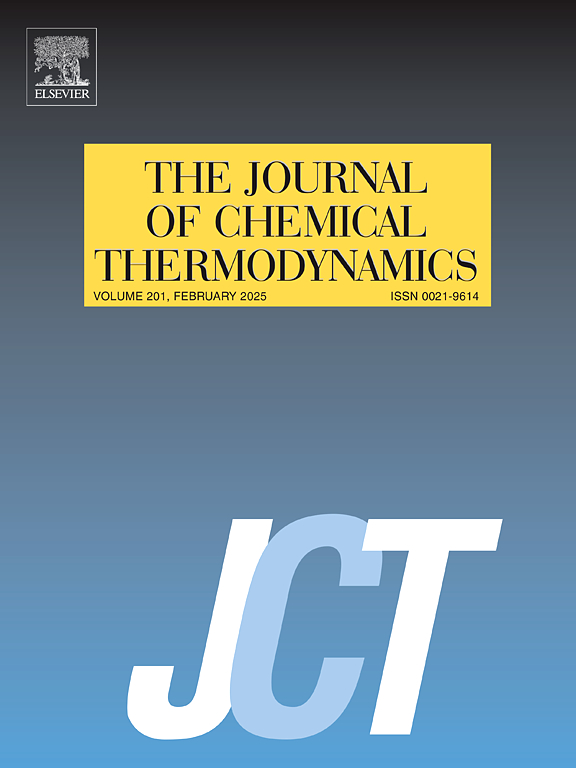Heat capacity and thermodynamic functions of stoichiometric rare earth oxychlorides (REOCl)
IF 2.2
3区 工程技术
Q3 CHEMISTRY, PHYSICAL
引用次数: 0
Abstract
This work investigates the heat capacity and thermodynamic properties of three rare earth oxychlorides (REOCl), TmOCl, NdOCl, and YOCl. To understand their thermodynamic landscapes, we measured their heat capacities from 1.8 to 300 K. Our results indicate the presence of several Schottky anomalies at low temperatures (below 7 K), and TmOCl had an additional Schottky anomaly centered around 25 K, which we attribute to a contribution from f-block electrons. We fitted the data to theoretical functions and used these models to derive the standard entropy, enthalpy, and Gibbs energy. Using previously published enthalpy of formation data, we determined the Gibbs energies of formation from the elements and the oxides and chlorides at selected temperatures. At 298.15 K, the Gibbs energy of formation relative to oxides and chlorides was calculated to be −59.4 kJ·mol−1, −41.0 kJ·mol−1, and − 11.1 kJ·mol−1 for NdOCl, YOCl, and TmOCl, respectively. The Gibbs energy of formation of REOCl relative to the elements at 298.15 K was calculated to be −952.3 kJ·mol−1, −967.4 kJ·mol−1, and − 938.9 kJ·mol−1 for NdOCl, YOCl, and TmOCl, respectively. These results confirm the stability of REOCl relative to the elements and the binary chlorides and oxides.
化学计量稀土氯氧化物(REOCl)的热容和热力学函数
本文研究了三种稀土氧氯化物(REOCl), TmOCl, NdOCl和YOCl的热容量和热力学性质。为了了解它们的热力学景观,我们测量了它们的热容从1.8到300 K。我们的结果表明,在低温(低于7 K)存在几个Schottky异常,TmOCl在25 K附近有一个额外的Schottky异常,我们将其归因于f区电子的贡献。我们将数据拟合到理论函数中,并使用这些模型推导出标准熵、焓和吉布斯能。利用先前发表的生成焓数据,我们确定了元素、氧化物和氯化物在选定温度下的吉布斯生成能。在298.15 K下,NdOCl、YOCl和TmOCl相对于氧化物和氯化物的吉布斯生成能分别为- 59.4 kJ·mol - 1、- 41.0 kJ·mol - 1和- 11.1 kJ·mol - 1。在298.15 K下,NdOCl、YOCl和TmOCl的REOCl相对于元素的吉布斯生成能分别为- 952.3 kJ·mol - 1、- 967.4 kJ·mol - 1和- 938.9 kJ·mol - 1。这些结果证实了REOCl相对于元素、二元氯化物和氧化物的稳定性。
本文章由计算机程序翻译,如有差异,请以英文原文为准。
求助全文
约1分钟内获得全文
求助全文
来源期刊

Journal of Chemical Thermodynamics
工程技术-热力学
CiteScore
5.60
自引率
15.40%
发文量
199
审稿时长
79 days
期刊介绍:
The Journal of Chemical Thermodynamics exists primarily for dissemination of significant new knowledge in experimental equilibrium thermodynamics and transport properties of chemical systems. The defining attributes of The Journal are the quality and relevance of the papers published.
The Journal publishes work relating to gases, liquids, solids, polymers, mixtures, solutions and interfaces. Studies on systems with variability, such as biological or bio-based materials, gas hydrates, among others, will also be considered provided these are well characterized and reproducible where possible. Experimental methods should be described in sufficient detail to allow critical assessment of the accuracy claimed.
Authors are encouraged to provide physical or chemical interpretations of the results. Articles can contain modelling sections providing representations of data or molecular insights into the properties or transformations studied. Theoretical papers on chemical thermodynamics using molecular theory or modelling are also considered.
The Journal welcomes review articles in the field of chemical thermodynamics but prospective authors should first consult one of the Editors concerning the suitability of the proposed review.
Contributions of a routine nature or reporting on uncharacterised materials are not accepted.
 求助内容:
求助内容: 应助结果提醒方式:
应助结果提醒方式:


